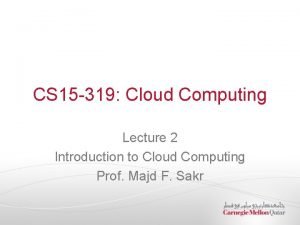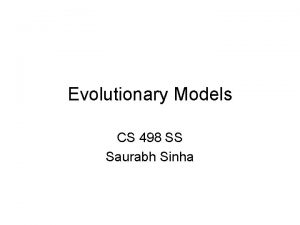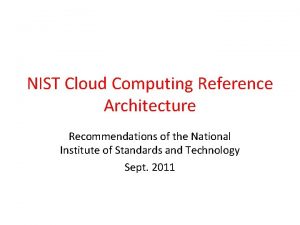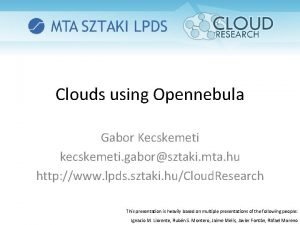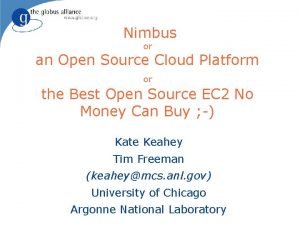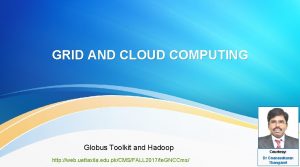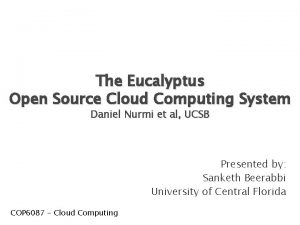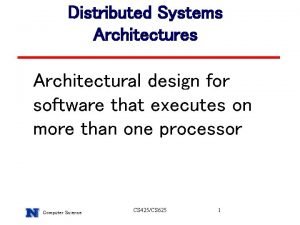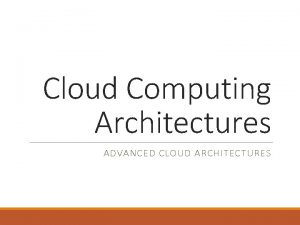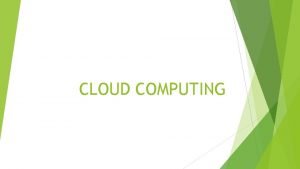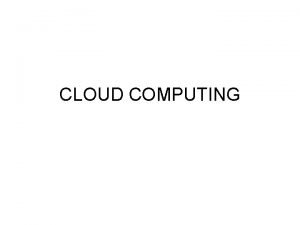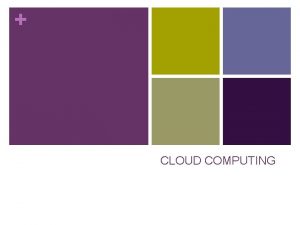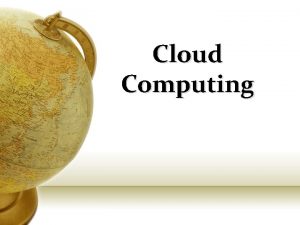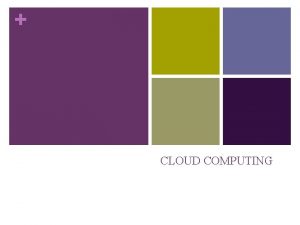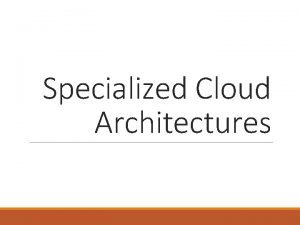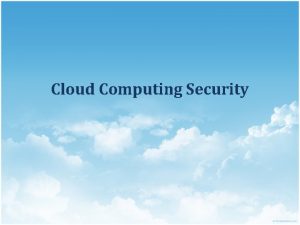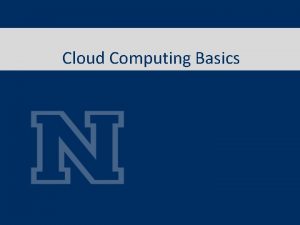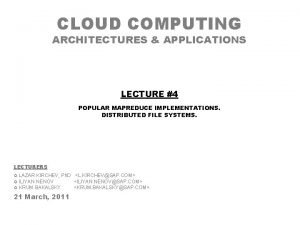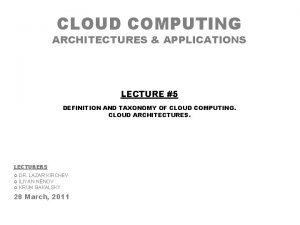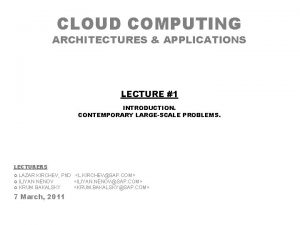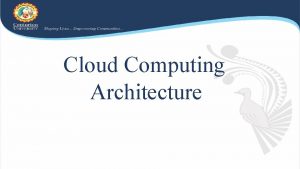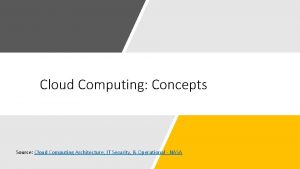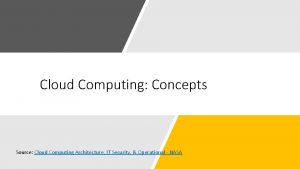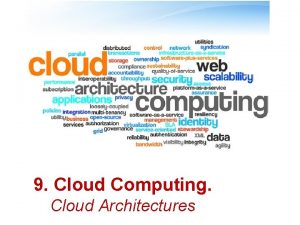CLOUD COMPUTING ARCHITECTURES APPLICATIONS LECTURE 6 ARCHITECTURE OF

























- Slides: 25

CLOUD COMPUTING ARCHITECTURES & APPLICATIONS LECTURE #6 ARCHITECTURE OF CLOUD APPLICATIONS. CLOUD COMPUTING USE CASE SCENARIOS. LECTURERS LAZAR KIRCHEV, Ph. D <L. KIRCHEV@SAP. COM> ILIYAN NENOV <ILIYAN. NENOV@SAP. COM> KRUM BAKALSKY <KRUM. BAKALSKY@SAP. COM> 21 March, 2011

OUTLINE Examples Specifics Use for cloud applications of cloud applications’ architecture case scenarios Customer scenarios Developer requirements Security scenarios Conclusion 2011 Sofia University “Sv. Kliment Ohridski” > Faculty of Mathematics and Informatics > Cloud Computing Architecture and Applications 2

Architecture of Cloud Applications

Examples for cloud applications Processing pipelines – document, image, video processing, indexing, data mining Batch processing – back office applications, log analysis, nightly builds, automated testing, business analytics Websites – used only during the day, or for particular event, or particular part of the year Scalable web applications, search engines, mapping engines 2011 Sofia University “Sv. Kliment Ohridski” > Faculty of Mathematics and Informatics > Cloud Computing Architecture and Applications 4

Application programming interfaces Levels of APIs Level 1 – The wire: At this level, the developer writes directly to the wire format of the request Level 2 – Language-Specific Toolkits: Developers at this level use a language specific toolkit Level 3 – Service-Specific Toolkits: The developer uses a higher-level toolkit to work with a particular service Level 4 – Service-Neutral Toolkits: A developer working at this level uses a common interface to multiple cloud computing providers Categories of APIs Category 1 – Ordinary Programming Category 2 – Deployment: APIs to deploy applications to the cloud Category 3 – Cloud Services: APIs to work with cloud services Category 4 – Image and Infrastructure Management: API to manage VM images and infrastructure Category 5 – Internal Interfaces: APIs for the internal interfaces between parts of the cloud infrastructure 2011 Sofia University “Sv. Kliment Ohridski” > Faculty of Mathematics and Informatics > Cloud Computing Architecture and Applications 5

Developer roles Client Application developer – writes cloud-based client applications for end users Application developer – writes traditional applications that use the cloud Deployers – package, deploy and maintain applications that use the cloud Administrators – work with applications at multiple levels, including deployment and infrastructure management Cloud Providers – work with the infrastructure beneath their cloud offerings 2011 Sofia University “Sv. Kliment Ohridski” > Faculty of Mathematics and Informatics > Cloud Computing Architecture and Applications 6

Specifics of cloud applications’ architecture Consists of components, scalable on their own Each component implements a service interface, responsible for its own scalability Loosely coupled components If one fails, the others continue Ensure resilience Automatic failure recovery 2011 Sofia University “Sv. Kliment Ohridski” > Faculty of Mathematics and Informatics > Cloud Computing Architecture and Applications 7

Specifics of cloud applications’ architecture Use parallelism Distribute tasks on multiple machines Multithreaded requests Effective aggregation of results, calculated in parallel Use on-demand resources Achieves best cost-effectiveness 2011 Sofia University “Sv. Kliment Ohridski” > Faculty of Mathematics and Informatics > Cloud Computing Architecture and Applications 8

Specifics of cloud application’ architecture Cloud application example – Grep. The. Web Searching in web data using a regular expression language Based on Amazon Web Services Amazon S 3 for storage Amazon SQS for asynchronous messaging Amazon Simple. DB for intermediate results Amazon EC 2 for running Hadoop for distributed processing Implements the discussed architectural characteristics 2011 Sofia University “Sv. Kliment Ohridski” > Faculty of Mathematics and Informatics > Cloud Computing Architecture and Applications 9

Use Case Scenarios 2011 Sofia University “Sv. Kliment Ohridski” > Faculty of Mathematics and Informatics > Cloud Computing Architecture and Applications 10

End user to cloud End users access applications running on the cloud Requirements – identity, open client, security, SLAs 2011 Sofia University “Sv. Kliment Ohridski” > Faculty of Mathematics and Informatics > Cloud Computing Architecture and Applications 11

Enterprise to cloud to end user Customers and employees access applications on the public cloud Requirements – identity, open client, federated identity, location awareness, metering and monitoring, management and governance, security, common file format for VMs, common APIs for cloud storage and middleware, data and application federation, SLAs and benchmark, lifecycle management 2011 Sofia University “Sv. Kliment Ohridski” > Faculty of Mathematics and Informatics > Cloud Computing Architecture and Applications 12

Enterprise to cloud Cloud applications integrated with internal IT capabilities Requirements – in addition to the requirements for the enterprise to cloud to end user scenario, deployment, industry-specific standards and protocols 2011 Sofia University “Sv. Kliment Ohridski” > Faculty of Mathematics and Informatics > Cloud Computing Architecture and Applications 13

Enterprise to cloud to enterprise Cloud applications running in the public cloud and interoperating with partner applications Requirements – as for enterprise to cloud scenario, plus transactions and concurrency and interoperability 2011 Sofia University “Sv. Kliment Ohridski” > Faculty of Mathematics and Informatics > Cloud Computing Architecture and Applications 14

Private cloud A cloud hosted by an organization inside that organization’s firewall Requirements – open client, metering and monitoring, management and governance, security, deployment, interoperability, a common VM format, SLAs. Does not require – identity, federated identity, location awareness, transactions, industry standards, common APIs for cloud middleware and lifecycle management 2011 Sofia University “Sv. Kliment Ohridski” > Faculty of Mathematics and Informatics > Cloud Computing Architecture and Applications 15

Changing cloud vendors An organization using cloud services switches cloud providers or work with additional providers Requirements – open client, location awareness, security, SLAs, a common file format for VMs, common APIs for cloud storage and middleware Change Saa. S vendors – industry specific standards Change middleware vendors – industryspecific standards, common APIs for cloud middleware Changing cloud storage vendors – common API for cloud storage Changing VM hosts – common format for VMs 2011 Sofia University “Sv. Kliment Ohridski” > Faculty of Mathematics and Informatics > Cloud Computing Architecture and Applications 16

Hybrid cloud Multiple clouds work together, coordinated by a cloud broker that federates data, applications, user identity, security and other details Requirements – all previous requirements, except transactions and concurrency 2011 Sofia University “Sv. Kliment Ohridski” > Faculty of Mathematics and Informatics > Cloud Computing Architecture and Applications 17

Customer scenarios Payroll Processing (Enterprise to Cloud) Processing time reduced Hardware requirements reduced Elasticity enabled for future expansion Logistics & Project Management (Enterprise to Cloud to End User) Processing time reduced Manual tasks eliminated Development environment updated and streamlined 2011 Sofia University “Sv. Kliment Ohridski” > Faculty of Mathematics and Informatics > Cloud Computing Architecture and Applications 18

Customer scenarios Central Government (Private Cloud) IT expertise consolidated Hardware requirements reduced Local Government (Hybrid Cloud) IT expertise consolidated Hardware requirements reduced Astronomic Data Processing (Enterprise to Cloud to End User) Hardware expenses greatly reduced (processing power and storage) Energy costs greatly reduced Administration simplified 2011 Sofia University “Sv. Kliment Ohridski” > Faculty of Mathematics and Informatics > Cloud Computing Architecture and Applications 19

Development requirements Caching Centralized logging Databases Identity Management Messaging – Point-to-Point Messaging – Publish-Subscribe Raw Compute / Job Processing Session Management Service Discovery SLAs Storage 2011 Sofia University “Sv. Kliment Ohridski” > Faculty of Mathematics and Informatics > Cloud Computing Architecture and Applications 20

Security scenarios Regulations Security Controls Asset Management Cryptography Data / Storage Security Endpoint Security Event Auditing and Reporting Identity, Roles, Access Control and Attributes Network Security Policies Service Automation Workload and Service Management 2011 Sofia University “Sv. Kliment Ohridski” > Faculty of Mathematics and Informatics > Cloud Computing Architecture and Applications 21

Security scenarios Security Federation Patterns Trust Identity Management Access Management Single Sign-On / Sign-Off Audit and Compliance Configuration Management 2011 Sofia University “Sv. Kliment Ohridski” > Faculty of Mathematics and Informatics > Cloud Computing Architecture and Applications 22

Conclusion Cloud applications should follow some architectural patterns in order to be appropriate for working in a cloud environment Basic real world use cases for cloud applications 2011 Sofia University “Sv. Kliment Ohridski” > Faculty of Mathematics and Informatics > Cloud Computing Architecture and Applications 23

END OF LECTURE #6

The Grid Headline area White space Drawing area 2011 Sofia University “Sv. Kliment Ohridski” > Faculty of Mathematics and Informatics > Cloud Computing Architecture and Applications 26
 Cloud computing cmu
Cloud computing cmu Cloud computing lecture
Cloud computing lecture Cs 498 cloud computing applications
Cs 498 cloud computing applications The cloud in cloud computing refers to
The cloud in cloud computing refers to Nist cloud reference model
Nist cloud reference model Opennebula architecture
Opennebula architecture Nimbus architecture in cloud computing
Nimbus architecture in cloud computing Globus toolkit architecture in cloud computing
Globus toolkit architecture in cloud computing Eucalyptus architecture in cloud computing
Eucalyptus architecture in cloud computing Green cloud computing architecture
Green cloud computing architecture 01:640:244 lecture notes - lecture 15: plat, idah, farad
01:640:244 lecture notes - lecture 15: plat, idah, farad Product architecture example
Product architecture example Database and storage architectures
Database and storage architectures Ansi/sparc
Ansi/sparc Switched backbone
Switched backbone Autoencoders
Autoencoders George schlossnagle
George schlossnagle Product architecture example
Product architecture example Gui architectures
Gui architectures Database system architectures
Database system architectures Cdn architectures
Cdn architectures Aaron bannert
Aaron bannert Independent data mart architecture
Independent data mart architecture Isa meaning computer
Isa meaning computer E commerce architecture and technologies
E commerce architecture and technologies Banking system architecture diagram
Banking system architecture diagram
